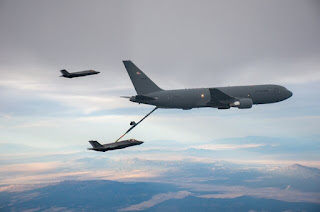KC-46A Refueling Accident With F-22 Spurs Review of System Reliability
On July 8, 2025, a U.S. Air Force KC-46A Pegasus tanker experienced a significant in-flight incident while conducting aerial refueling operations with F-22 Raptor stealth fighters off the coast of Virginia. The tanker, operating under the callsign FELL 81 and assigned to McConnell Air Force Base in Kansas, lost its refueling boom mid-mission, prompting the crew to declare an emergency and divert to Seymour Johnson Air Force Base in North Carolina.
 |
| KC-46A. mcchord.af.mil |
The KC-46A, a Boeing-built aircraft based on the commercial 767 airframe, has faced persistent technical challenges since its introduction. The boom, a critical component for transferring fuel to receiving aircraft, has been a recurring source of concern. According to air traffic control audio cited in multiple reports, the crew of FELL 81 reported that “our boom has detached from the aircraft” and initiated emergency procedures. Flight tracking data showed the tanker initially circling over the Chesapeake Bay, possibly to assess damage and dump fuel, before heading south toward its emergency landing site.
This event is not isolated. The KC-46A fleet has experienced similar boom-related incidents in recent years. In August 2024, another KC-46A suffered a boom malfunction while refueling an F-15E Strike Eagle, resulting in an emergency landing at Travis Air Force Base, California. In that case, the boom reportedly broke in half and remained extended during landing, causing additional damage to the aircraft’s auxiliary power unit exhaust cone. These incidents have raised questions about the reliability of the KC-46A’s refueling system, particularly its Remote Vision System (RVS), which boom operators use to guide the boom during refueling.
The RVS, currently in its first iteration (RVS 1.0), has been criticized for visual distortions and poor visibility under certain lighting conditions. These limitations can lead to operational errors, including misalignment during boom contact. The Air Force and Boeing are developing RVS 2.0, a redesigned system intended to address these shortcomings. However, its deployment has been delayed multiple times, with the latest estimates placing its completion in summer 2027, three years behind the original schedule.
The KC-46A’s boom also suffers from mechanical issues, such as excessive stiffness, which prevents effective refueling of certain aircraft like the A-10 Thunderbolt II. A redesigned actuator is in development to mitigate this problem. Despite these efforts, the Pentagon’s Office of the Director of Operational Test and Evaluation noted in its 2024 annual report that the KC-46A is not meeting many of its suitability metrics.
The July 8 incident occurred on the AR-636 refueling track east of Norfolk, Virginia. The F-22s involved reportedly returned to base safely, though the extent of any damage to the fighters remains unclear. The KC-46A involved had flown two missions the previous day without reported issues, suggesting that the boom failure may have been sudden or related to cumulative stress.
The Air Force has acknowledged the incident and initiated a safety investigation to determine the cause and assess the damage. According to a spokesperson for the 22nd Air Refueling Wing, the investigation will be “complete and methodical,” examining all aspects of the mission and aircraft performance.
This latest boom detachment adds to a growing list of operational setbacks for the KC-46A program. The aircraft has previously been grounded due to wing cracks and has faced scrutiny over its ability to support stealth aircraft refueling missions. Although the Air Force has gradually lifted some operational restrictions, the KC-46A remains limited in its deployment for combat missions. The aircraft is currently authorized for general flights, training exercises, and transport operations, but not for active combat support involving stealth platforms.
The KC-46A program reflects broader challenges in integrating advanced technologies into legacy mission profiles. While the aircraft is intended to replace aging KC-135 tankers and enhance the Air Force’s refueling capabilities, its technical hurdles have delayed full operational capability. The recurring boom failures underscore the importance of robust testing and system reliability in mission-critical platforms.
As the investigation into the July 8 incident continues, further details may clarify whether the boom failure was due to mechanical fatigue, operator error, or systemic design flaws. The outcome will likely influence future modifications to the KC-46A fleet and inform broader decisions about aerial refueling strategy and procurement.





